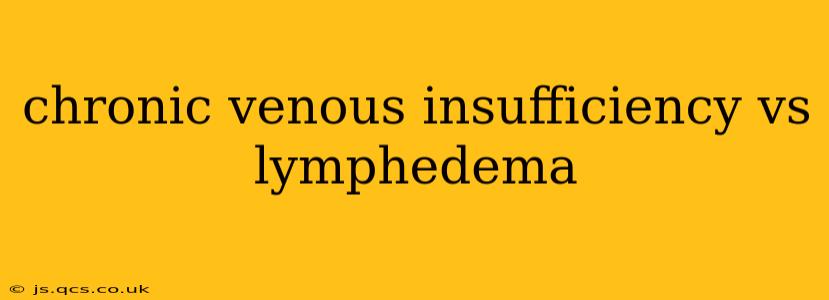Chronic venous insufficiency (CVI) and lymphedema are both conditions that cause swelling in the legs and feet, making them easily confused. However, they have distinct underlying causes, symptoms, and treatment approaches. Understanding the differences is crucial for proper diagnosis and effective management. This comprehensive guide will clarify the key distinctions between CVI and lymphedema, answering common questions and providing valuable information for patients and healthcare professionals.
What is Chronic Venous Insufficiency (CVI)?
Chronic venous insufficiency is a condition where the veins in the legs and feet don't effectively return blood to the heart. This leads to a buildup of blood in the lower extremities, resulting in swelling, pain, and other symptoms. The primary cause is often venous valve dysfunction, preventing blood from flowing upwards against gravity. Risk factors for CVI include:
- Deep vein thrombosis (DVT): Blood clots in the deep veins can damage valves and lead to CVI.
- Varicose veins: Enlarged, twisted veins close to the skin's surface indicate weakened valves.
- Age: The risk of CVI increases with age, as valves weaken over time.
- Obesity: Excess weight puts added pressure on the veins.
- Prolonged standing or sitting: Reduces venous return.
- Pregnancy: Hormonal changes and increased pressure on the veins can contribute to CVI.
- Family history: A genetic predisposition can increase the risk.
What is Lymphedema?
Lymphedema is a condition characterized by swelling caused by a blockage in the lymphatic system. The lymphatic system is a network of vessels and nodes that helps remove waste and fluid from the body's tissues. When this system is impaired, fluid accumulates, leading to swelling, often in the arms or legs. Lymphedema can be primary (present at birth or developing early in life due to genetic factors) or secondary (developing later in life due to damage or blockage of the lymphatic system). Common causes of secondary lymphedema include:
- Cancer treatment: Surgery, radiation therapy, and lymph node removal can damage the lymphatic system.
- Infections: Infections that affect the lymphatic system can lead to blockage.
- Trauma: Injuries that damage the lymphatic system can cause lymphedema.
- Filariasis: A parasitic infection that can cause lymphatic blockage.
What are the main symptoms of CVI and Lymphedema?
While both conditions cause swelling, there are some key differences in their symptom presentation:
Chronic Venous Insufficiency (CVI):
- Swelling: Often worse at the end of the day and improves with leg elevation.
- Pain: Aching, heaviness, or cramping in the legs.
- Skin changes: Discoloration (brownish discoloration around the ankles), dry skin, eczema, and ulcers.
- Varicose veins: Visible, enlarged, and twisted veins.
Lymphedema:
- Swelling: Can be present at any time of day and may not improve with leg elevation.
- Pain: Can range from mild to severe. Often a feeling of tightness or fullness.
- Skin changes: Skin may be thickened and firm (hardening of the skin). Infections are more common due to lymphatic system impairment.
- Limited range of motion: Due to the swelling and tightness.
How are CVI and Lymphedema diagnosed?
Diagnosing both conditions often involves a physical examination and several tests:
- Physical examination: Assessing the swelling, skin changes, and other symptoms.
- Doppler ultrasound: Uses sound waves to assess blood flow in the veins.
- Lymphoscintigraphy: Uses a radioactive tracer to visualize the lymphatic system.
- MRI or CT scan: May be used to rule out other conditions or to assess the extent of lymphatic damage.
What are the treatment options for CVI and Lymphedema?
Treatment approaches differ significantly:
Chronic Venous Insufficiency (CVI):
- Compression therapy: Compression stockings or bandages improve venous return.
- Elevation: Elevating the legs reduces swelling.
- Exercise: Regular exercise improves circulation.
- Lifestyle changes: Weight loss, avoiding prolonged standing or sitting.
- Pharmacological treatment: Medications to reduce swelling or prevent blood clots.
- Surgical procedures: In severe cases, surgical interventions may be necessary (e.g., vein stripping, ablation).
Lymphedema:
- Manual lymphatic drainage (MLD): A specialized massage technique that helps move fluid out of the affected area.
- Compression therapy: Similar to CVI, but often requires more specialized bandages.
- Exercise: Gentle range-of-motion exercises and light cardio.
- Complete decongestive therapy (CDT): A comprehensive program combining MLD, compression, skin care, and exercise.
- Pharmacological treatment: Antibiotics for infections.
What is the long-term outlook for CVI and Lymphedema?
Both CVI and lymphedema are chronic conditions, meaning they are long-lasting and may require ongoing management. With proper treatment, the symptoms of CVI can often be managed effectively, preventing complications like leg ulcers. Lymphedema management focuses on reducing swelling and preventing infections, but the condition itself is often not curable. Early diagnosis and adherence to the treatment plan are crucial for improving the quality of life for individuals with both CVI and lymphedema.
How are CVI and Lymphedema different in terms of their underlying causes?
CVI stems from problems with the venous system’s ability to return blood to the heart, primarily due to malfunctioning valves. Lymphedema, conversely, arises from a blockage or dysfunction within the lymphatic system, hindering its ability to drain fluid from tissues. This fundamental difference in the affected circulatory system is key to understanding their distinct characteristics.
Can CVI and Lymphedema occur together?
Yes, it's possible for a person to experience both CVI and lymphedema simultaneously. Conditions that damage the lymphatic system, such as cancer treatment, can also affect the venous system, increasing the likelihood of both conditions coexisting. The presence of both requires a tailored treatment plan addressing the unique needs of each condition.
This information is for general knowledge and should not be considered medical advice. Always consult with a healthcare professional for diagnosis and treatment of any medical condition.
